Economic Principles and Decision Making: Module 5 Assessment 2
VerifiedAdded on 2023/03/23
|9
|1280
|53
Homework Assignment
AI Summary
This assignment, completed for ECON6000, analyzes business principles and decision-making using regression analysis and economic models. The solution addresses three problems: the first examines factors affecting the demand for energy bars, including income, tariff rates, and the number of stores, using a regression model to determine the impact of these factors. The second problem investigates the impact of tariffs on energy bar demand, showing how tariffs affect the price and export volume of the product. The third problem explores the welfare analysis of trade, comparing free trade and protectionist measures like tariffs to assess their impact on consumer and producer surplus and overall societal welfare. The assignment uses figures and economic theories to illustrate the effects of tariffs and trade on the company and the broader economy, providing detailed explanations and referencing relevant economic literature.
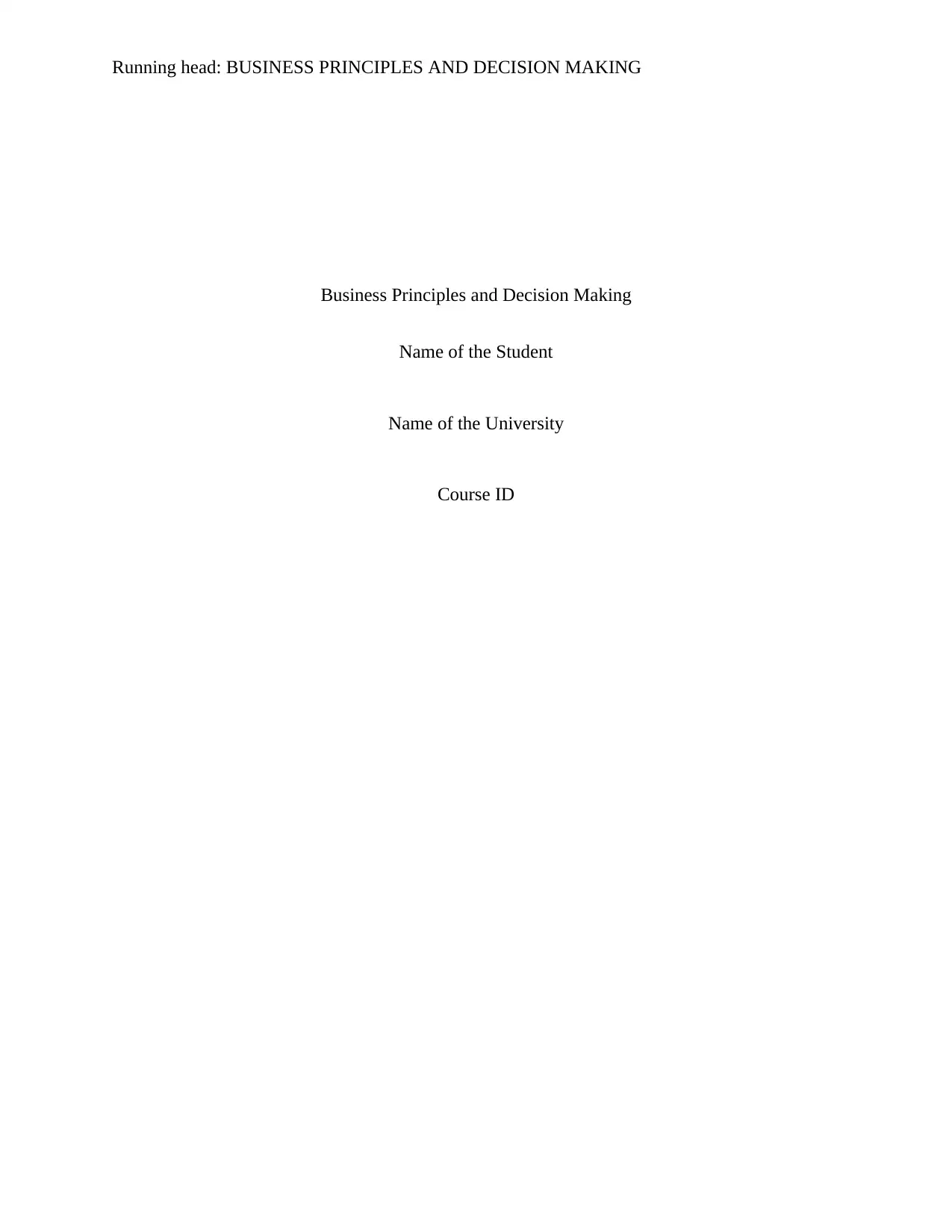
Running head: BUSINESS PRINCIPLES AND DECISION MAKING
Business Principles and Decision Making
Name of the Student
Name of the University
Course ID
Business Principles and Decision Making
Name of the Student
Name of the University
Course ID
Paraphrase This Document
Need a fresh take? Get an instant paraphrase of this document with our AI Paraphraser

1BUSINESS PRINCIPLES AND DECISION MAKING
Table of Contents
Problem A........................................................................................................................................2
Question 1....................................................................................................................................2
Problem B........................................................................................................................................3
Question 1....................................................................................................................................3
Question 2....................................................................................................................................4
Problem C........................................................................................................................................5
Question 1....................................................................................................................................5
Reference list...................................................................................................................................7
Table of Contents
Problem A........................................................................................................................................2
Question 1....................................................................................................................................2
Problem B........................................................................................................................................3
Question 1....................................................................................................................................3
Question 2....................................................................................................................................4
Problem C........................................................................................................................................5
Question 1....................................................................................................................................5
Reference list...................................................................................................................................7
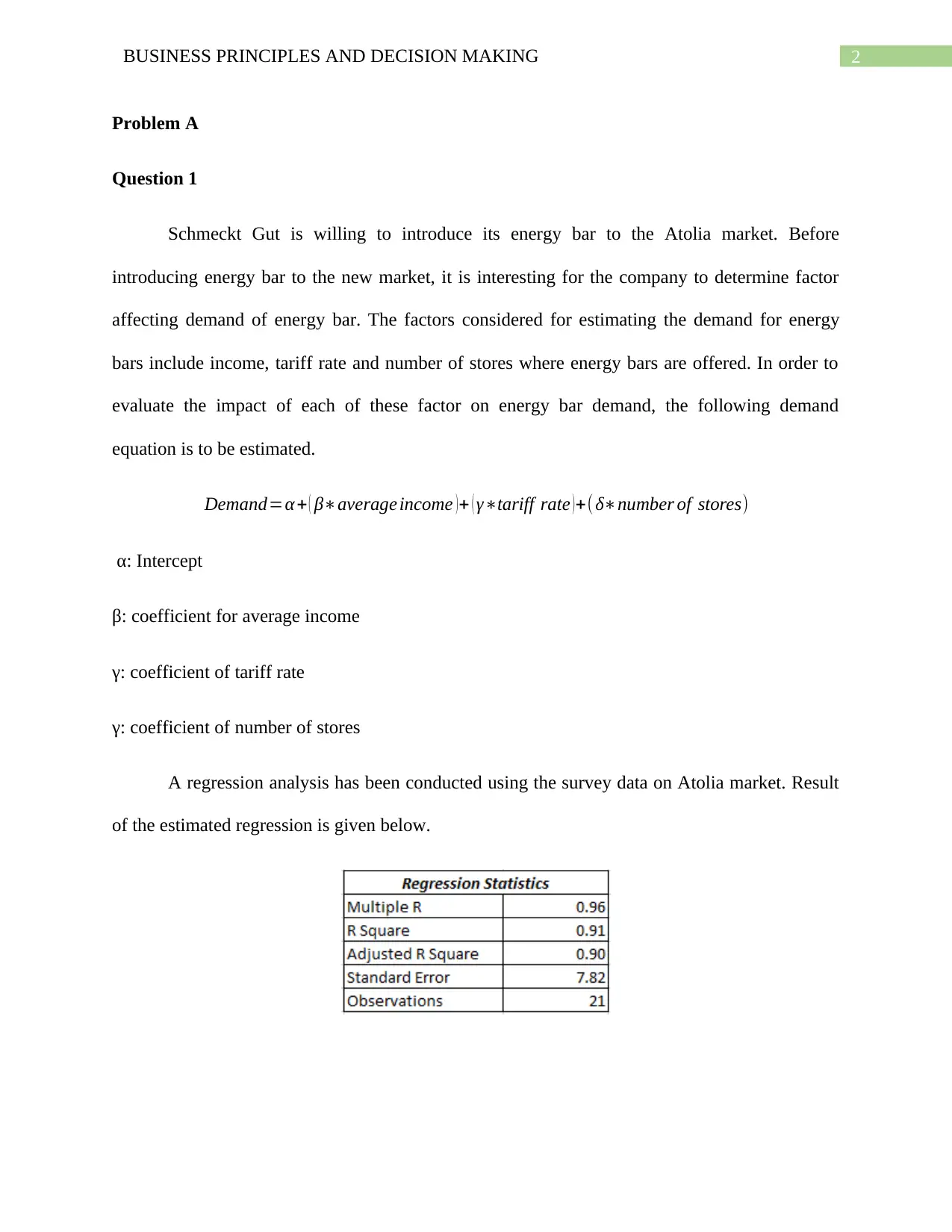
2BUSINESS PRINCIPLES AND DECISION MAKING
Problem A
Question 1
Schmeckt Gut is willing to introduce its energy bar to the Atolia market. Before
introducing energy bar to the new market, it is interesting for the company to determine factor
affecting demand of energy bar. The factors considered for estimating the demand for energy
bars include income, tariff rate and number of stores where energy bars are offered. In order to
evaluate the impact of each of these factor on energy bar demand, the following demand
equation is to be estimated.
Demand=α + ( β∗average income ) + ( γ∗tariff rate ) +(δ∗number of stores)
α: Intercept
β: coefficient for average income
γ: coefficient of tariff rate
γ: coefficient of number of stores
A regression analysis has been conducted using the survey data on Atolia market. Result
of the estimated regression is given below.
Problem A
Question 1
Schmeckt Gut is willing to introduce its energy bar to the Atolia market. Before
introducing energy bar to the new market, it is interesting for the company to determine factor
affecting demand of energy bar. The factors considered for estimating the demand for energy
bars include income, tariff rate and number of stores where energy bars are offered. In order to
evaluate the impact of each of these factor on energy bar demand, the following demand
equation is to be estimated.
Demand=α + ( β∗average income ) + ( γ∗tariff rate ) +(δ∗number of stores)
α: Intercept
β: coefficient for average income
γ: coefficient of tariff rate
γ: coefficient of number of stores
A regression analysis has been conducted using the survey data on Atolia market. Result
of the estimated regression is given below.
⊘ This is a preview!⊘
Do you want full access?
Subscribe today to unlock all pages.

Trusted by 1+ million students worldwide
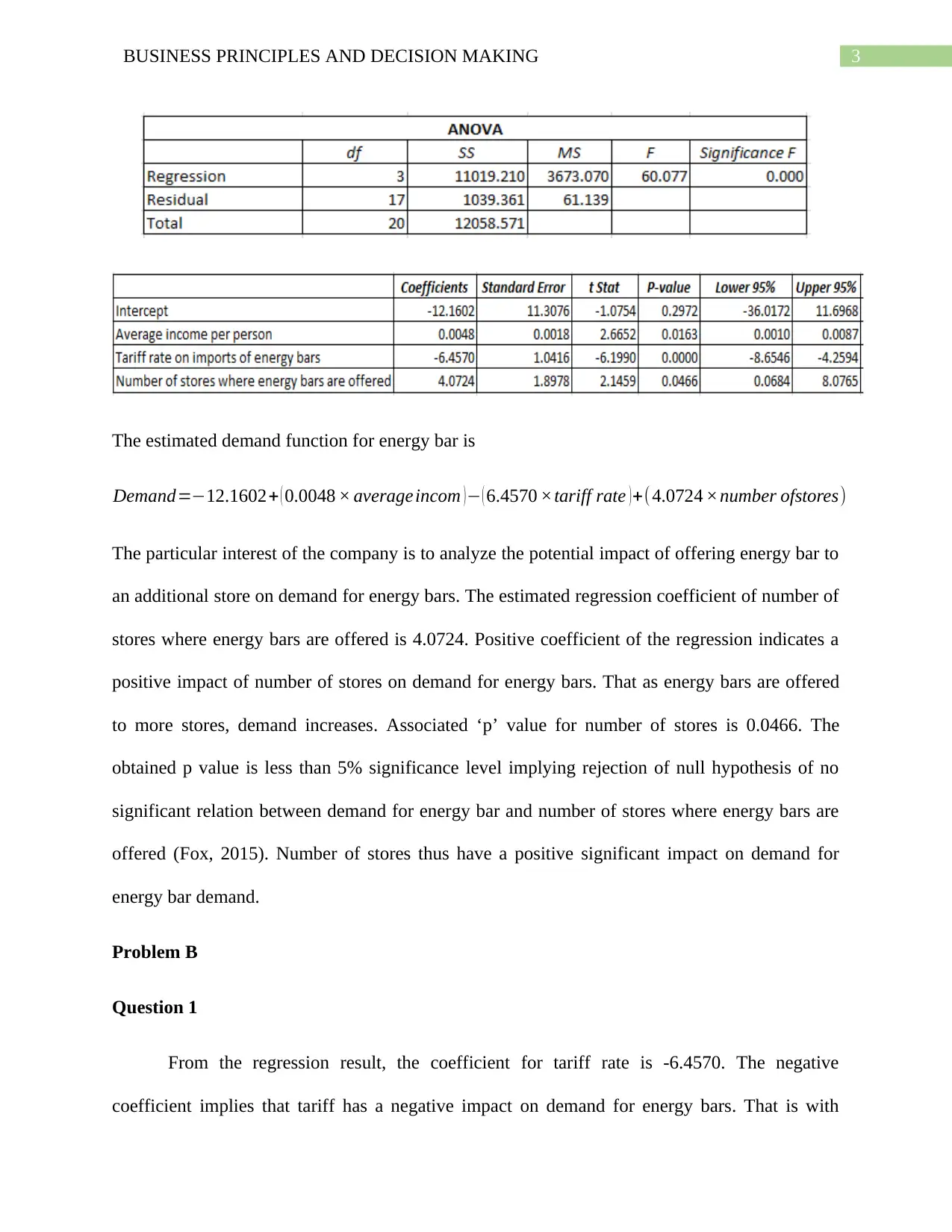
3BUSINESS PRINCIPLES AND DECISION MAKING
The estimated demand function for energy bar is
Demand=−12.1602+ ( 0.0048 × average incom ) − ( 6.4570 ×tariff rate ) +(4.0724 ×number ofstores)
The particular interest of the company is to analyze the potential impact of offering energy bar to
an additional store on demand for energy bars. The estimated regression coefficient of number of
stores where energy bars are offered is 4.0724. Positive coefficient of the regression indicates a
positive impact of number of stores on demand for energy bars. That as energy bars are offered
to more stores, demand increases. Associated ‘p’ value for number of stores is 0.0466. The
obtained p value is less than 5% significance level implying rejection of null hypothesis of no
significant relation between demand for energy bar and number of stores where energy bars are
offered (Fox, 2015). Number of stores thus have a positive significant impact on demand for
energy bar demand.
Problem B
Question 1
From the regression result, the coefficient for tariff rate is -6.4570. The negative
coefficient implies that tariff has a negative impact on demand for energy bars. That is with
The estimated demand function for energy bar is
Demand=−12.1602+ ( 0.0048 × average incom ) − ( 6.4570 ×tariff rate ) +(4.0724 ×number ofstores)
The particular interest of the company is to analyze the potential impact of offering energy bar to
an additional store on demand for energy bars. The estimated regression coefficient of number of
stores where energy bars are offered is 4.0724. Positive coefficient of the regression indicates a
positive impact of number of stores on demand for energy bars. That as energy bars are offered
to more stores, demand increases. Associated ‘p’ value for number of stores is 0.0466. The
obtained p value is less than 5% significance level implying rejection of null hypothesis of no
significant relation between demand for energy bar and number of stores where energy bars are
offered (Fox, 2015). Number of stores thus have a positive significant impact on demand for
energy bar demand.
Problem B
Question 1
From the regression result, the coefficient for tariff rate is -6.4570. The negative
coefficient implies that tariff has a negative impact on demand for energy bars. That is with
Paraphrase This Document
Need a fresh take? Get an instant paraphrase of this document with our AI Paraphraser
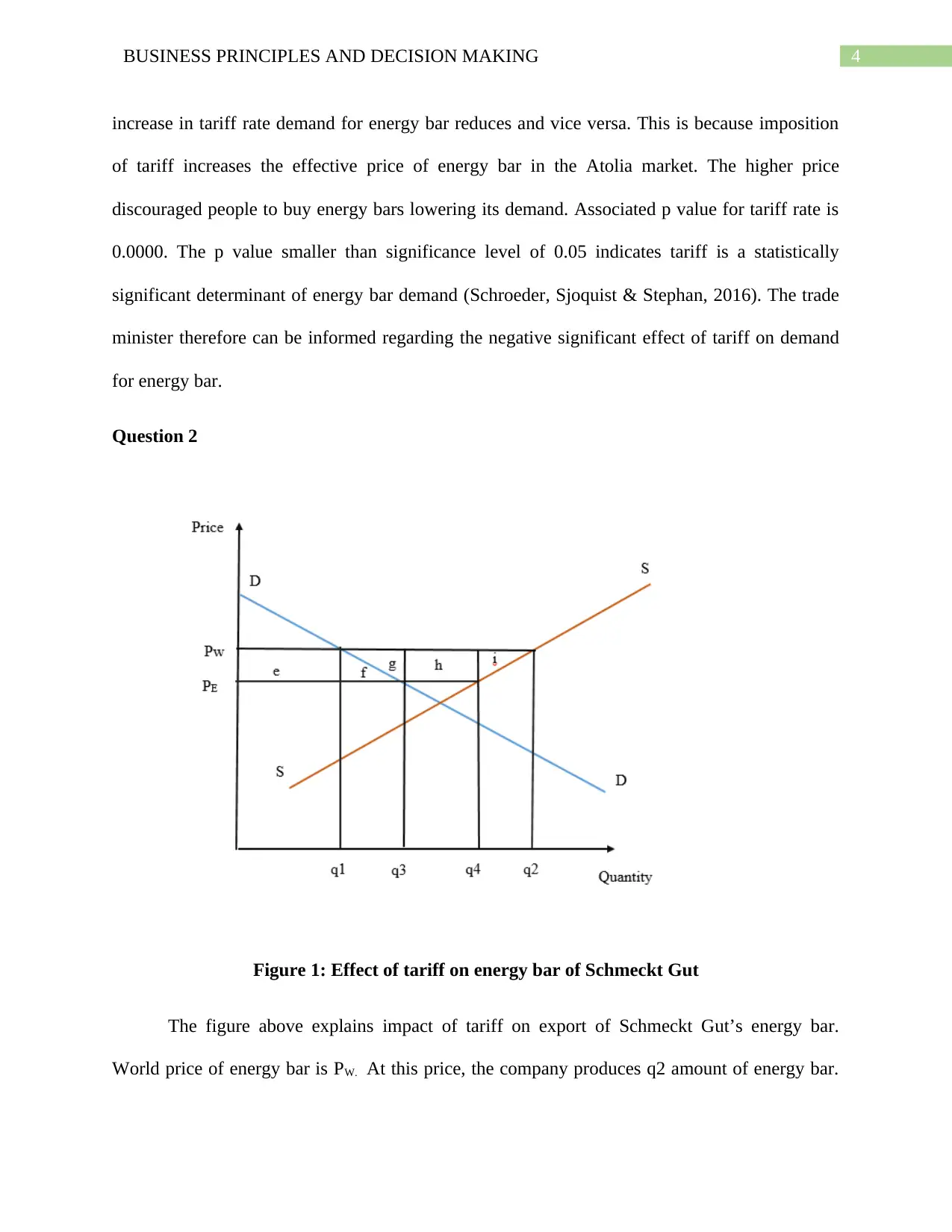
4BUSINESS PRINCIPLES AND DECISION MAKING
increase in tariff rate demand for energy bar reduces and vice versa. This is because imposition
of tariff increases the effective price of energy bar in the Atolia market. The higher price
discouraged people to buy energy bars lowering its demand. Associated p value for tariff rate is
0.0000. The p value smaller than significance level of 0.05 indicates tariff is a statistically
significant determinant of energy bar demand (Schroeder, Sjoquist & Stephan, 2016). The trade
minister therefore can be informed regarding the negative significant effect of tariff on demand
for energy bar.
Question 2
Figure 1: Effect of tariff on energy bar of Schmeckt Gut
The figure above explains impact of tariff on export of Schmeckt Gut’s energy bar.
World price of energy bar is PW. At this price, the company produces q2 amount of energy bar.
increase in tariff rate demand for energy bar reduces and vice versa. This is because imposition
of tariff increases the effective price of energy bar in the Atolia market. The higher price
discouraged people to buy energy bars lowering its demand. Associated p value for tariff rate is
0.0000. The p value smaller than significance level of 0.05 indicates tariff is a statistically
significant determinant of energy bar demand (Schroeder, Sjoquist & Stephan, 2016). The trade
minister therefore can be informed regarding the negative significant effect of tariff on demand
for energy bar.
Question 2
Figure 1: Effect of tariff on energy bar of Schmeckt Gut
The figure above explains impact of tariff on export of Schmeckt Gut’s energy bar.
World price of energy bar is PW. At this price, the company produces q2 amount of energy bar.
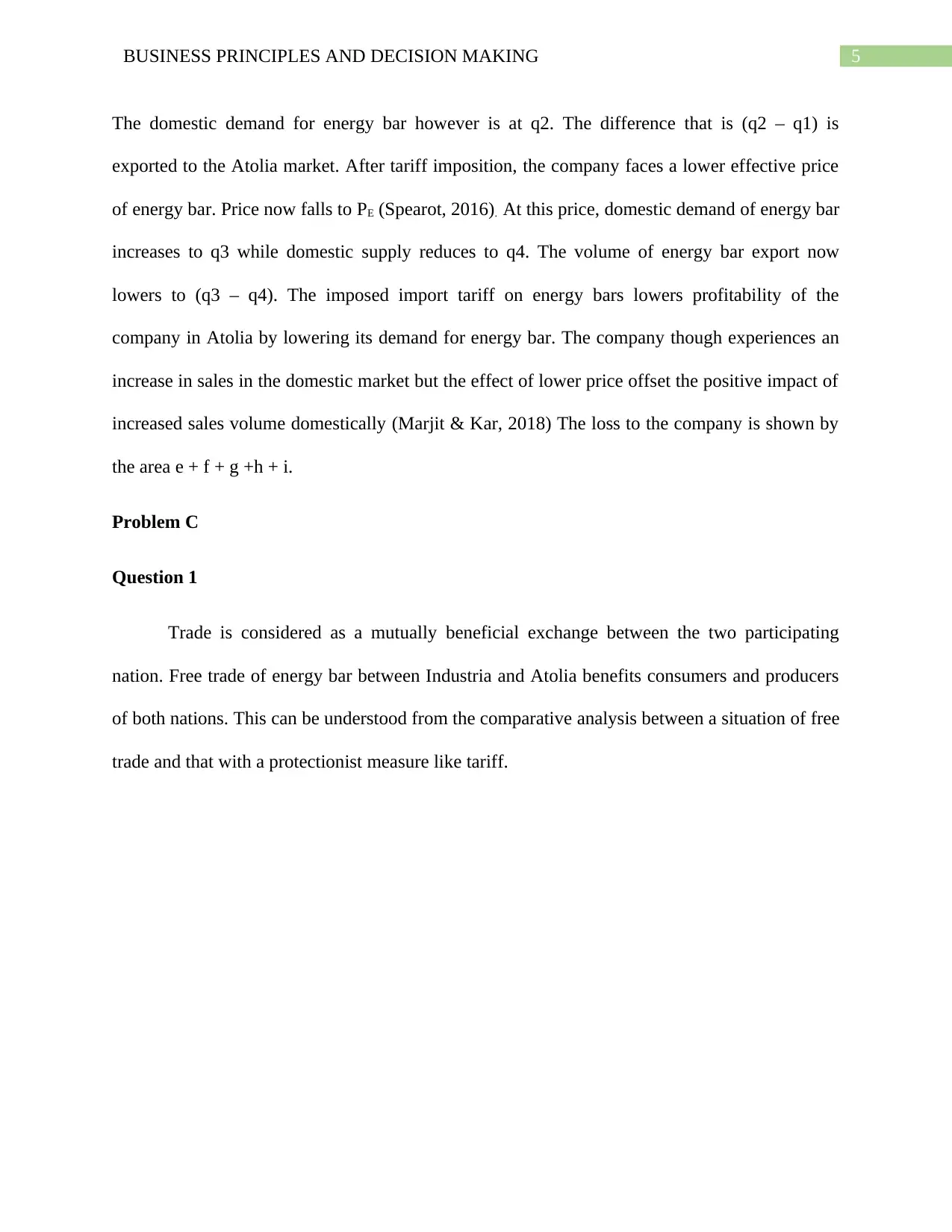
5BUSINESS PRINCIPLES AND DECISION MAKING
The domestic demand for energy bar however is at q2. The difference that is (q2 – q1) is
exported to the Atolia market. After tariff imposition, the company faces a lower effective price
of energy bar. Price now falls to PE (Spearot, 2016). At this price, domestic demand of energy bar
increases to q3 while domestic supply reduces to q4. The volume of energy bar export now
lowers to (q3 – q4). The imposed import tariff on energy bars lowers profitability of the
company in Atolia by lowering its demand for energy bar. The company though experiences an
increase in sales in the domestic market but the effect of lower price offset the positive impact of
increased sales volume domestically (Marjit & Kar, 2018) The loss to the company is shown by
the area e + f + g +h + i.
Problem C
Question 1
Trade is considered as a mutually beneficial exchange between the two participating
nation. Free trade of energy bar between Industria and Atolia benefits consumers and producers
of both nations. This can be understood from the comparative analysis between a situation of free
trade and that with a protectionist measure like tariff.
The domestic demand for energy bar however is at q2. The difference that is (q2 – q1) is
exported to the Atolia market. After tariff imposition, the company faces a lower effective price
of energy bar. Price now falls to PE (Spearot, 2016). At this price, domestic demand of energy bar
increases to q3 while domestic supply reduces to q4. The volume of energy bar export now
lowers to (q3 – q4). The imposed import tariff on energy bars lowers profitability of the
company in Atolia by lowering its demand for energy bar. The company though experiences an
increase in sales in the domestic market but the effect of lower price offset the positive impact of
increased sales volume domestically (Marjit & Kar, 2018) The loss to the company is shown by
the area e + f + g +h + i.
Problem C
Question 1
Trade is considered as a mutually beneficial exchange between the two participating
nation. Free trade of energy bar between Industria and Atolia benefits consumers and producers
of both nations. This can be understood from the comparative analysis between a situation of free
trade and that with a protectionist measure like tariff.
⊘ This is a preview!⊘
Do you want full access?
Subscribe today to unlock all pages.

Trusted by 1+ million students worldwide

6BUSINESS PRINCIPLES AND DECISION MAKING
Figure 2: Welfare analysis of trade
The domestic demand and supply curve in Industria market is given as Dd and Sd.
Without trade, equilibrium in the Industria market is at E. The consumers earn a surplus given by
the triangle NEP3 and producers earn a surplus of EAP3. Now, as Industria opens up to free trade,
price coincides with the world price at P1. The lower price increase consumer surplus equivalent
to the larger triangle to NP1F. Domestic producers of Industria though suffers a loss, but gain in
consumer surplus exceeds the loss to the producers resulting in an increase in aggregate welfare
(Irwin, 2015).
Now, consider the effect of a tariff on social welfare. Any imposed tariff of T increase
domestic price to P1 + T. As a result of higher price, consumers suffer a loss in surplus given by
the area B + S + T + V + U. Domestic producers now enjoy an additional surplus given by the
area B. Government revenue from the tariff is T + V. Because of tariff, society suffers a net loss
given by the area S + U.
Figure 2: Welfare analysis of trade
The domestic demand and supply curve in Industria market is given as Dd and Sd.
Without trade, equilibrium in the Industria market is at E. The consumers earn a surplus given by
the triangle NEP3 and producers earn a surplus of EAP3. Now, as Industria opens up to free trade,
price coincides with the world price at P1. The lower price increase consumer surplus equivalent
to the larger triangle to NP1F. Domestic producers of Industria though suffers a loss, but gain in
consumer surplus exceeds the loss to the producers resulting in an increase in aggregate welfare
(Irwin, 2015).
Now, consider the effect of a tariff on social welfare. Any imposed tariff of T increase
domestic price to P1 + T. As a result of higher price, consumers suffer a loss in surplus given by
the area B + S + T + V + U. Domestic producers now enjoy an additional surplus given by the
area B. Government revenue from the tariff is T + V. Because of tariff, society suffers a net loss
given by the area S + U.
Paraphrase This Document
Need a fresh take? Get an instant paraphrase of this document with our AI Paraphraser

7BUSINESS PRINCIPLES AND DECISION MAKING
The tariff thus not have a distortionary effect on energy bar demand of the company, but
also has an overall negative impact on welfare of Industria (Himics & Britz, 2016) The
regression result indicating a negative effect of tariff on energy bar demand thus supports what is
suggested by the standard trade theory.
The tariff thus not have a distortionary effect on energy bar demand of the company, but
also has an overall negative impact on welfare of Industria (Himics & Britz, 2016) The
regression result indicating a negative effect of tariff on energy bar demand thus supports what is
suggested by the standard trade theory.
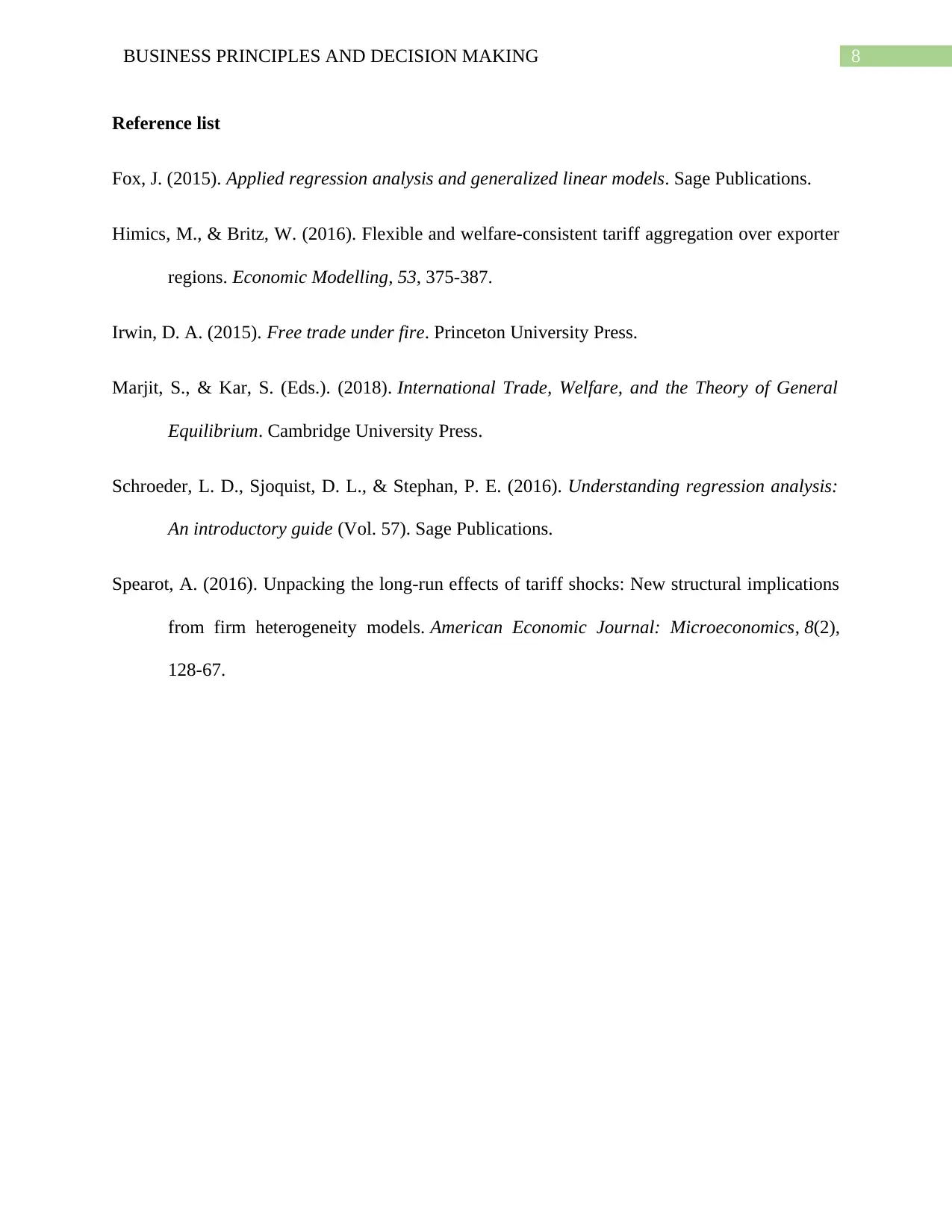
8BUSINESS PRINCIPLES AND DECISION MAKING
Reference list
Fox, J. (2015). Applied regression analysis and generalized linear models. Sage Publications.
Himics, M., & Britz, W. (2016). Flexible and welfare-consistent tariff aggregation over exporter
regions. Economic Modelling, 53, 375-387.
Irwin, D. A. (2015). Free trade under fire. Princeton University Press.
Marjit, S., & Kar, S. (Eds.). (2018). International Trade, Welfare, and the Theory of General
Equilibrium. Cambridge University Press.
Schroeder, L. D., Sjoquist, D. L., & Stephan, P. E. (2016). Understanding regression analysis:
An introductory guide (Vol. 57). Sage Publications.
Spearot, A. (2016). Unpacking the long-run effects of tariff shocks: New structural implications
from firm heterogeneity models. American Economic Journal: Microeconomics, 8(2),
128-67.
Reference list
Fox, J. (2015). Applied regression analysis and generalized linear models. Sage Publications.
Himics, M., & Britz, W. (2016). Flexible and welfare-consistent tariff aggregation over exporter
regions. Economic Modelling, 53, 375-387.
Irwin, D. A. (2015). Free trade under fire. Princeton University Press.
Marjit, S., & Kar, S. (Eds.). (2018). International Trade, Welfare, and the Theory of General
Equilibrium. Cambridge University Press.
Schroeder, L. D., Sjoquist, D. L., & Stephan, P. E. (2016). Understanding regression analysis:
An introductory guide (Vol. 57). Sage Publications.
Spearot, A. (2016). Unpacking the long-run effects of tariff shocks: New structural implications
from firm heterogeneity models. American Economic Journal: Microeconomics, 8(2),
128-67.
⊘ This is a preview!⊘
Do you want full access?
Subscribe today to unlock all pages.

Trusted by 1+ million students worldwide
1 out of 9
Related Documents
Your All-in-One AI-Powered Toolkit for Academic Success.
+13062052269
info@desklib.com
Available 24*7 on WhatsApp / Email
![[object Object]](/_next/static/media/star-bottom.7253800d.svg)
Unlock your academic potential
Copyright © 2020–2025 A2Z Services. All Rights Reserved. Developed and managed by ZUCOL.



